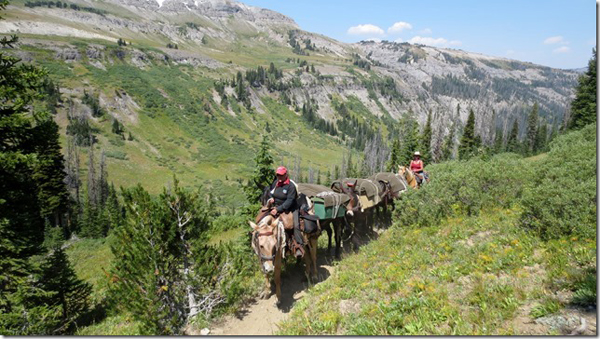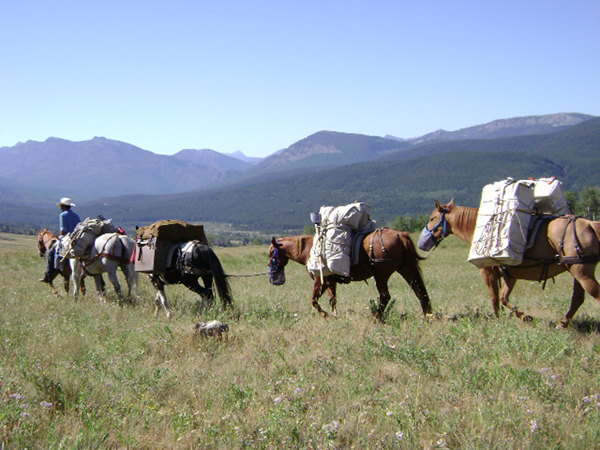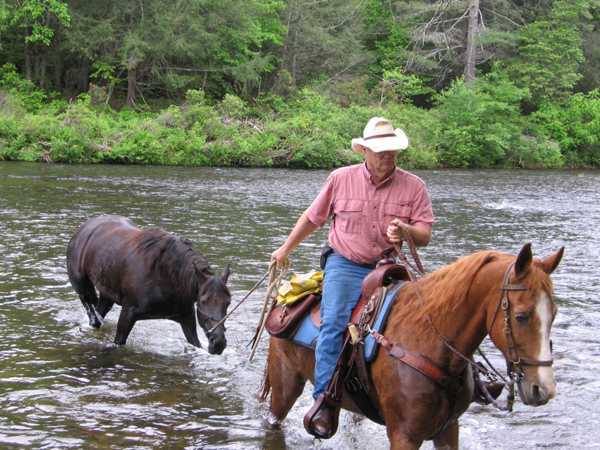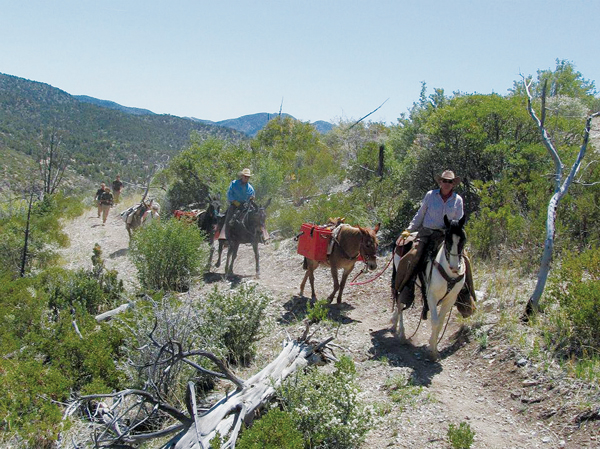How Equestrians Can Help Protect the Future of Riding Trails
You don’t have to own your own horse or even be a frequent trail rider to recognize the importance of conservation of horse trails. Learn how you can become involved to help protect your local riding trails in a quickly modernizing world.
by Jocelyn Pierce
Now more than ever, horse trails need support to remain accessible for the public to enjoy them. An overburdened Forest Service is unable to maintain all the recreational trails available to the public, hindering equestrians from accessing many riding trails. Horses and use of the horse are a tradition in United States culture and history that must be preserved for future generations. Only by creating an awareness of the importance of our riding trails and the danger they are facing can we have an impact on the American public and land management agencies.

BCHA Diane Eek and Brenda Cordonnier packing in the Teton Wilderness in Wyoming, approaching the Continental Divide.
Conditions of Horse Trails
There are currently 155 national forests in the United States, with over 158,000 miles of recreational trails for horseback riders, hikers, bicyclists, and others to use. That’s roughly six times around the globe at the equator. With all those miles of trails, it’s difficult for the Forest Service to maintain all of them. The Government Accountability Office completed a study on national forest maintenance and found in 2012 only 37 percent of their 158,000 miles of trails had some level of maintenance performed and only one-quarter met the Forest Service’s standards. The Forest Service estimated their trail maintenance backlog to be $314 million in 2012.
Dennis Dailey has been involved in wilderness management for 40 years, and has seen a dramatic shift in the way trails are maintained since he began his career. Dailey worked for the Forest Service, and for Back Country Horsemen as Wilderness Advisor. He has an expert’s understanding of trail conditions. Dailey explains wilderness areas have seen much neglect over the last 60 years and some trails haven’t even been touched in ten years.
As budgets declined, the maintenance priorities of the Forest Service shifted from focusing on public safety and other concerns to simply responding to public demand for access to wild places. At such high financial costs, and with such a backlog of trail maintenance to be completed, recreational trail use is severely threatened.
The Back Country Horsemen of America (BCHA) educates on the proper use of horses in wilderness areas and works to ensure that public lands stay open. They work with government and private agencies to help maintain and manage public lands and work to educate others in the use of wilderness areas. Back Country Horsemen is not a riding club, most members own horses, but the focus is on keeping trails open in national forests, national parks, and state parks.

BCHA Montana.
Jim McGarvey, Chairman of Back Country Horsemen of American, describes how BCHA works to help the overburdened Forest Service. BCHA volunteered 372,000 hours working on trails, spending about 260,000 hours in National Forests in an effort to connect people with public lands by keeping trails accessible. Many volunteers also put in a lot financially out of their own pockets.
Gene Wood, PhD, founder of Equestrian Trails and Conservation Awareness notes many equestrians don’t realize the difference between well designed, constructed, and maintained trails, as opposed to a trail with erosion or trails that aren’t environmentally sound in general. It’s important to think about the land itself, and as Wood puts it, “the ecological matrix that the trail is embedded.”
According to McGarvey, new land management plans are developed in National Parks every 20 years and every 15 years in National Forests. An Environmental Impact Analysis is completed, which is key, because usage for trails changes through the years. “Twenty years ago mountain bikes weren’t really around, but now there is a big presence of them in the parks, so land management plans need to be adjusted,” says McGarvey, “Back Country Horsemen works at local levels to make sure that horses are included in those plans.” Equestrians need to insist and show their desire for access to recreational trails.
Not only does BCHA work at the local level, believing in strong grassroots organization, but also at the national level, teaming up with organizations such as the Wilderness Society, American Hiking Society, and the Pacific Crest Trail Society who share a common cause.
Back Country Horsemen was established in 1973 in Montana’s Flathead Valley by wilderness and hunting outfitters looking to maintain trails and keep backcountry areas wild but accessible. Since their constitution was drafted and enacted in the mid 1980s, the BCHA has grown from four to 175 chapters in 26 states with over 14,000 members.

Gene Wood horseback riding.
Why We Trail Ride: Embracing the Heritage of the Horse
Gene Wood has made it his life’s mission to work on conservation efforts, teaching conservation policy at Clemson University and working to help horse people understand conservation issues that affect riding trails and protect what he believes is a “cultural heritage in a natural heritage setting.” Equestrians not only need to realize the importance of the horse, but need to think back on the history of the land. We need to view trail riding, and the use of the horse on the landscape as a natural and cultural heritage.
The human-horse connection is a phenomenon all of us as equestrians can appreciate. This partnership is evident through history since the domestication of the horse. The United States has a long steeped equestrian heritage and tradition. Horses were used for work, warfare, transportation, and sport, playing an integral part in American culture. From the American cowboy in the West, East Coast foxhunts and races, and everything in between, the importance of the horse is widespread and evident.
Continuing on with this heritage, horses are still used for sport, recreation, and companionship in the United States. According to Wood, the horse has a huge impact on the American psyche. The horse is linked with adventurers, frontiersmen and is associated with freedom and individualism, ideals of American society. Trail riders come the closest to this reenactment, riding through rugged terrain as explorers once did.
Trail riding also allows equestrians to gain a closer connection to nature and their horse. “It is spiritual experience for me,” notes Wood, “I wish more people could get into thinking about the wonder of it all, the fact that I am out here in all this beauty, all this wonder, and what does this mean in time and space?”
While trail riding, riders can slow down and notice all the land has to offer-wildflowers, geological formations, wildlife, to name a few. To really appreciate what the land can offer is to understand the value of the land and trail riding and the importance of keeping trails open.
“We must be introspective about our values-why we ride, why we trail ride, what our values are for the places we ride,” says Wood. As horse enthusiasts, owners, and riders we have a responsibility to realize the importance about what we do and ensure there will be lands for our horses and activities for the generations to come.

BCHA Bristlecone working with USFS.
What Riders Can Do to Help Protect Equine Trails
At a time when horses are being phased off public lands, America has moved so far away from the land. So many live in an urban environment, disconnected from the natural world. Dennis Dailey has spent his career trying to raise awareness and getting people involved in its protection. He admits that many people, even horsemen, seem to wait until there is a crisis before they get involved to help.
Trail riders need to understand the importance of conservation and make an effort to educate themselves on policy, land management agencies, and statutes. We must involve the younger generations, to get them outdoors and experience the natural world for the future protection of trails.
Wood theorizes that in order to reach Americans, to make them understand the issues, we must capitalize on the idea of the horse and the freedom and ruggedness associated with horses and riding. “I realized that fewer than 1 percent of Americans own a horse, but all Americans own these lands,” said Wood. “We as horse owners are in this extremely small minority among Americans owning the public trust. We need to keep the rest of the American public empathetic with us and to want us out on the land.”
Riders need to ensure and protect the future of riding trails. We must not be so presumptuous to just assume that these trails are out here for us to use whenever we please. We must show the public and land management agencies our love for the land and the importance of the horse.
Consider joining your local Back Country Horsemen Chapter, local riding club, or even starting your own club in order to work together for a common interest. Volunteering to maintain trails, working with local agencies, and showing the public we care about keeping trails open is a starting point to raise awareness and safeguard conservation of riding trails.
About the Author: Jocelyn Pierce is an avid equestrian and lover of travel and photography. Her passion for adventure has led her on numerous excursions throughout North America and Europe. When she’s not riding and competing her homebred mare, she enjoys hiking, camping, and snapping photographs.




